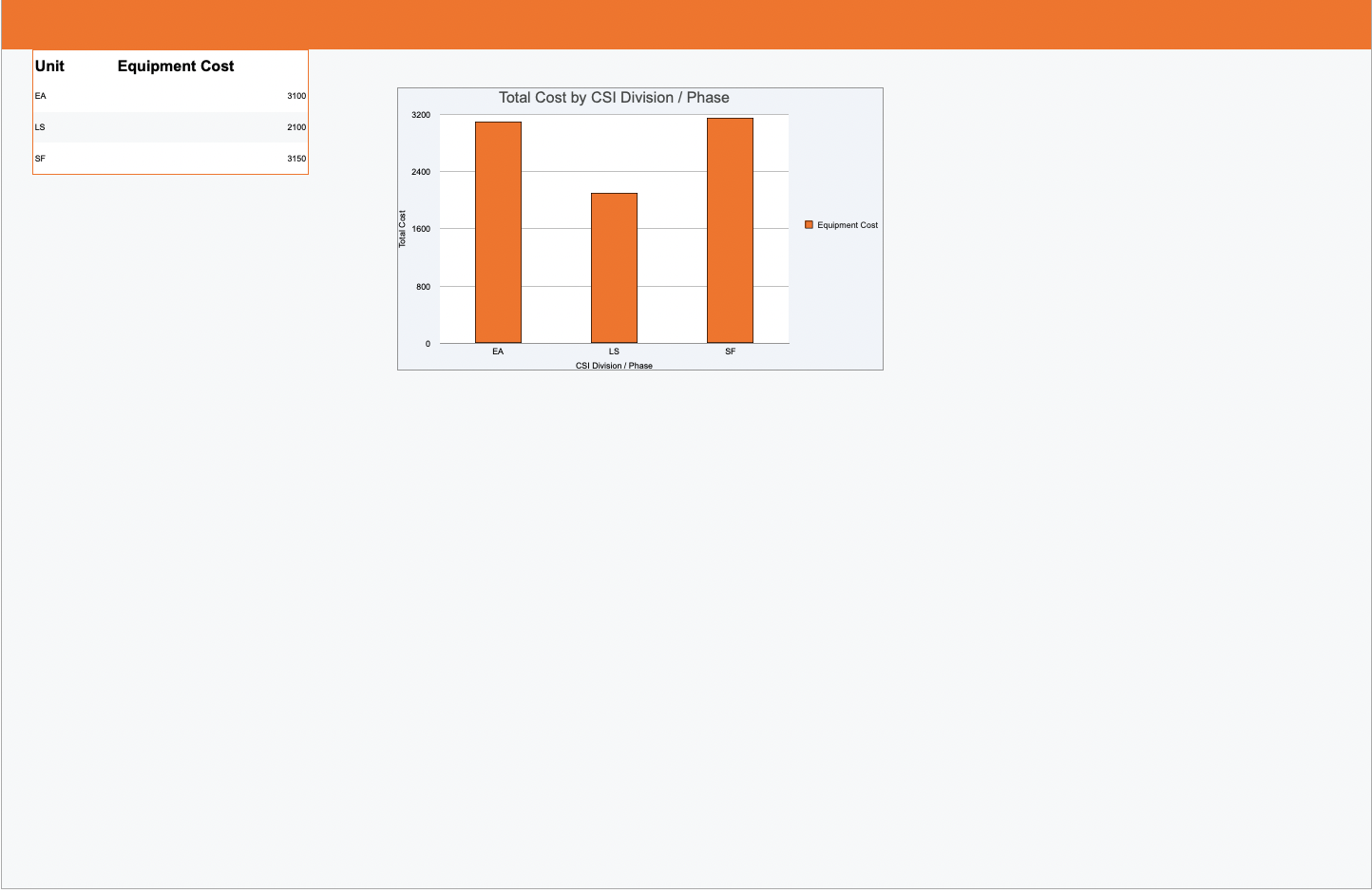— 8 min read
Construction Estimate Templates: A Guide for Project Managers



Last Updated Nov 11, 2025

Bruno Pasini
Senior Solutions Engineer, Overlay, PM & Preconstruction
Bruno Pasini is a Solutions Engineer at Procore, where he develops new tools to simplify and streamline the preconstruction process. He spent nearly 20 years as an estimator and project manager for general contractors and specialty contractors in New York and California. He currently lives in San Diego.

Nate Belcher
Assistant Project Manager
Nate Belcher brings almost a decade of industry experience to his current role as an Assistant Project Manager at Hubbell Realty Company. Before his current position, Nate served as an assistant superintendent, project engineer and an assistant commercial superintendent intern at Hubbell. Nate's career began with roles such as project manager intern at Russell Co. and Gas Engineering Intern at Mid American Energy Company, where he gained both technical and collaborative skills. He also has hands-on experience in residential construction from his time with Orville Belcher Construction and Remodeling. Nate holds a bachelor's degree in construction engineering from Iowa State University, and is based in West Des Moines.

Kristen Frisa
Contributing Writer
111 articles
Kristen Frisa is a contributing writer for Procore. She also contributes to a variety of industry publications as a freelance writer focused on finance and construction technology. Kristen holds a Bachelor of Arts in Philosophy and History from Western University, with a post-graduate certificate in journalism from Sheridan College. She lives in Ontario, Canada.
Last Updated Nov 11, 2025

The success of a construction project depends on accurate, detailed construction estimates. Estimates serve as the financial blueprint for a project, guiding decision-making and ensuring that all stakeholders are aligned.
Construction estimate templates can help simplify the process, making sure all key elements of project pricing have been considered and providing a standard format that makes it easier for stakeholders to understand.
This article will discuss the importance of comprehensive and accurate construction estimates, when and how to create the best estimate — and how templates are a key tool that can benefit the process.
Table of contents
What is a construction estimate?
A construction estimate is a detailed forecast of the costs associated with a construction project. It includes an assessment of the expenses for materials, labor, equipment and any other resources required to complete the project.
Typically prepared by a cost estimator or quantity surveyor, the process of creating a construction estimate involves analyzing the project's scope, identifying all necessary components and tasks, and calculating the anticipated costs. This includes direct costs such as raw materials and wages, as well as indirect costs like overhead, permits, and insurance.
A well-prepared construction estimate helps in setting realistic budgets, securing financing and providing a basis for managing construction project costs. It also aids in decision-making and planning, ensuring resources are allocated efficiently and that the project remains financially viable throughout its lifecycle.
Types of Construction Estimates
Various types of estimates are used to address different stages of a project and varying levels of detail. Here are some common types of construction estimates:
Preliminary Estimate
Also known as a rough order of magnitude (ROM) estimate or a conceptual estimate, this is an early estimate used to provide a general idea of the project's cost. It is usually based on limited information and serves to assess the feasibility of a project before detailed design work begins.
Estimators collaborate closely with architects and project owners so each design iteration remains aligned with the project's architectural intentions and budgetary goals. These early estimates guide cooperative design adjustments, helping project teams make informed decisions that balance aesthetic desires with financial constraints.

D. Jesse Mase
Principle Operational Excellence Specialist
Procore Technologies
Detailed Estimate
This type of estimate is based on complete drawings, specifications, and a thorough understanding of the project. It includes detailed calculations of all costs, including labor, materials, equipment, and overhead. A detailed estimate is often used for bidding and final project budgeting.
Quantity Estimate
Quantity estimates focus specifically on the amount of materials and labor that will be needed on a construction project. They can be especially helpful for creating work packages for specialty contractors.
Bid Estimate
Prepared by contractors, this estimate is used to submit a bid for a project. It includes all direct and indirect costs, as well as the contractor's profit margin. It must be detailed and accurate to ensure a competitive bid.
Why Use a Construction Estimate Template?
A template can help estimators prepare construction estimates by providing a structured and consistent format to follow. Here are several ways a template can be beneficial.
Standardization
Templates ensure that all estimates adhere to a uniform structure, making it easier to compare and analyze different projects or elements within a project. This standardization helps maintain consistency across all estimates.
Efficiency
By using a predefined format, estimators can save time as they don't need to start from scratch for each new project. Templates provide placeholders and categories that guide the estimator in collecting and organizing information quickly.
Comprehensiveness
Well-designed templates include all necessary sections and details that an estimator might need to consider, such as materials, labor, equipment, overhead and contingencies. This reduces the likelihood of overlooking important elements.
Accuracy
Templates often come with built-in formulas for calculations, which can help in minimizing errors and increasing the accuracy of cost estimates. They can automatically sum up costs, apply tax rates or adjust for inflation.
Communication
A standardized format makes it easier to communicate estimates to stakeholders, such as clients, project managers and financial officers. It ensures that everyone understands the breakdown of costs and the basis for the estimate.
Documentation
Using templates provides a documented trail of how estimates were derived. This can be valuable for future reference, audits or when justifying costs to clients or regulatory bodies.
Scalability
Templates can be adapted for projects of different sizes and scopes, making them versatile tools for estimators working on a variety of projects.
Overall, construction estimate templates serve as valuable tools that enhance the efficiency, accuracy, and reliability of the estimating process, ultimately contributing to more successful project outcomes.
What Construction Estimates Should Include
There’s a lot going on over the course of any construction project, and many, many costs to account for. Construction estimates should strive to consider all of the costs involved in delivering a complete project to the client. Here are a few of the major areas to cover in a completed estimate:
Description of the Work
Every construction estimate template should start with a clear description of the work to be done. This includes detailed explanations of each phase of the project, the tasks involved and any specific requirements or constraints. A well-defined scope of work helps prevent misunderstandings and ensures that everyone knows exactly what is expected.
Duration of the Work
The timeline is a critical component of any construction estimate. It should outline the start and end dates of the project, as well as key milestones and deadlines. Understanding the duration of the work helps in planning resource allocation and scheduling, ensuring that the project stays on track.
Materials and Labor
Materials and labor costs are often the largest expenses in a construction project. An estimate should include a list of materials required, along with their costs and suppliers. It should also account for labor costs, including wages and any subcontractor fees. Accurate estimates in these areas are crucial for budgeting and cost control.
Hidden Costs
Hidden costs can derail a project if not accounted for in advance. These might include unexpected site conditions, regulatory compliance costs or unforeseen delays. A robust estimate will include contingencies for such hidden costs, providing a buffer to absorb any unexpected expenses.
Profit
Every project aims to be profitable, and the estimate should clearly outline the expected profit margin. This includes not just the direct costs but also overhead and any additional profits desired. Transparent profit calculations help in setting realistic financial expectations for all parties involved.
Carrying Costs
Carrying costs refer to the expenses incurred while holding the project over time, such as interest on loans or storage fees for materials. Including these costs in the estimate ensures that the financial plan covers all aspects of the project's lifecycle.
Payment Expectations
To avoid payment disputes, the estimate should detail the payment schedule, terms and conditions. Clear documentation on how and when payments will be made helps prevent conflicts and ensures smooth financial transactions throughout the project.
Free Download
Construction Estimate Template
- Free starter template
- Created by construction professionals
- Contains examples for template use
- XLXS file opens in Excel or Numbers



How to Write a Construction Estimate
Formatting a construction estimate effectively is key to clarity and professionalism. A well-structured estimate makes it easier for stakeholders to understand the costs involved and the scope of work. Here’s a recommended format:
Header
- Include your company’s name, logo and contact information.
- Add the client’s name and contact details.
- Provide the project name and address.
- Date the estimate and include an estimate number for tracking purposes.
Introduction
- Briefly describe the project and its objectives.
- State the scope of work covered by the estimate.
Detailed Breakdown of Costs
- Sections by Trade or Phase: Organize the estimate into sections based on trades (e.g., electrical, plumbing) or project phases (e.g., site preparation, foundation).
- Itemized Costs: List each item or task, including a description, quantity, unit cost, and total cost.
- Labor Costs: Include labor hours, rates and total labor costs for each section.
Materials and Equipment
- Detail the materials required, including quantities and costs.
- List equipment rental or purchase costs, if applicable.
Subcontractor Costs
- Include details of any subcontractor work, specifying the services provided and costs.
Overhead and Profit
- Clearly state overhead costs, such as administrative expenses, insurance, and permits.
- Specify the profit margin included in the estimate.
Contingency and Hidden Costs
- Add a contingency line item for unforeseen expenses.
- Include any potential hidden costs, such as site conditions or regulatory compliance fees.
Summary and Total
- Provide a summary section that totals all costs from each category.
- Clearly state the grand total.
Terms and Conditions
- Outline payment terms, including schedule and methods.
- Specify any terms related to changes or revisions to the estimate.
- Include any conditions or exclusions that apply to the estimate.
Signature and Approval
- Provide space for signatures and approval dates from both your company and the client.
Appendices or Attachments (if necessary)
- Attach any relevant documents, such as detailed drawings, specifications, or additional terms.
Following a specific format ensures a construction estimate is comprehensive, clear and easy to navigate, facilitating better communication with clients and other stakeholders.
Construction Technology and Construction Estimation Templates
Many construction management platforms provide construction estimation templates as part of their suite of tools. They may offer pre-designed templates, integrate with estimating software, allow for historical data to be imported to educate new estimates, and provide version control so that various individuals can provide input without causing chaos or confusion.
Stay updated on what’s happening in construction.
Subscribe to Blueprint, Procore’s free construction newsletter, to get content from industry experts delivered straight to your inbox.

Save time and improve accuracy with estimation templates.
Construction estimate templates are indispensable tools for project managers, especially in mid- to large-sized commercial projects.
A well-crafted estimate is more than just a set of numbers; it's a roadmap that guides the entire project team toward achieving their goals efficiently and effectively.
Was this article helpful?
Thank you for your submission.
0%
0%
You voted that this article was . Was this a mistake? If so, change your vote
Scroll less, learn more about construction.
Subscribe to The Blueprint, Procore’s construction newsletter, to get content from industry experts delivered straight to your inbox.
By clicking this button, you agree to our Privacy Notice and Terms of Service.
Thank you!
You’re signed up to receive The Blueprint newsletter from Procore. You can unsubscribe at any time.
Categories:
Written by

Bruno Pasini
Senior Solutions Engineer, Overlay, PM & Preconstruction | Procore Technologies
Bruno Pasini is a Solutions Engineer at Procore, where he develops new tools to simplify and streamline the preconstruction process. He spent nearly 20 years as an estimator and project manager for general contractors and specialty contractors in New York and California. He currently lives in San Diego.
View profile
Nate Belcher
Assistant Project Manager | Hubbell Realty
Nate Belcher brings almost a decade of industry experience to his current role as an Assistant Project Manager at Hubbell Realty Company. Before his current position, Nate served as an assistant superintendent, project engineer and an assistant commercial superintendent intern at Hubbell. Nate's career began with roles such as project manager intern at Russell Co. and Gas Engineering Intern at Mid American Energy Company, where he gained both technical and collaborative skills. He also has hands-on experience in residential construction from his time with Orville Belcher Construction and Remodeling. Nate holds a bachelor's degree in construction engineering from Iowa State University, and is based in West Des Moines.
View profile
Kristen Frisa
Contributing Writer | Procore
111 articles
Kristen Frisa is a contributing writer for Procore. She also contributes to a variety of industry publications as a freelance writer focused on finance and construction technology. Kristen holds a Bachelor of Arts in Philosophy and History from Western University, with a post-graduate certificate in journalism from Sheridan College. She lives in Ontario, Canada.
View profileExplore more helpful resources

Defending Against Financial & Legal Risks on Megaprojects
The construction industry has seen marked growth in megaprojects. Some experts classify any project over $500 million as a megaproject, while others argue that the build needs to be $1...

Unlocking Project Intelligence: Moving from Raw Data to Actionable Insights
The construction industry faces a wide range of challenges, from ongoing labor shortages to frequent cost overruns. But some the biggest hurdles all stem from unpredictability. The general contractors (GCs)...

Who is accountable for innovation in construction?
Everyone says construction needs to innovate—but no one agrees on who’s actually responsible for making it happen. Is it the owner? The builders? The tech vendor? Or is innovation everyone’s...

Integrated Project Delivery in Practice: A Framework for Collaboration
On construction projects, traditional delivery methods put different stakeholders in their own silos. While the design team feeds drawings and specifications to the general contractor (GC), the GC’s expertise in...
Free Tools
Calculators
Use our calculators to estimate the cost of construction materials for your next project.
Templates
Find a template to help you with your construction project tasks.
Material Price Tracker
Get the latest U.S. retail prices and view historical trends for common building materials.
Glossary
Explore key terms and phrases used in the industry.
